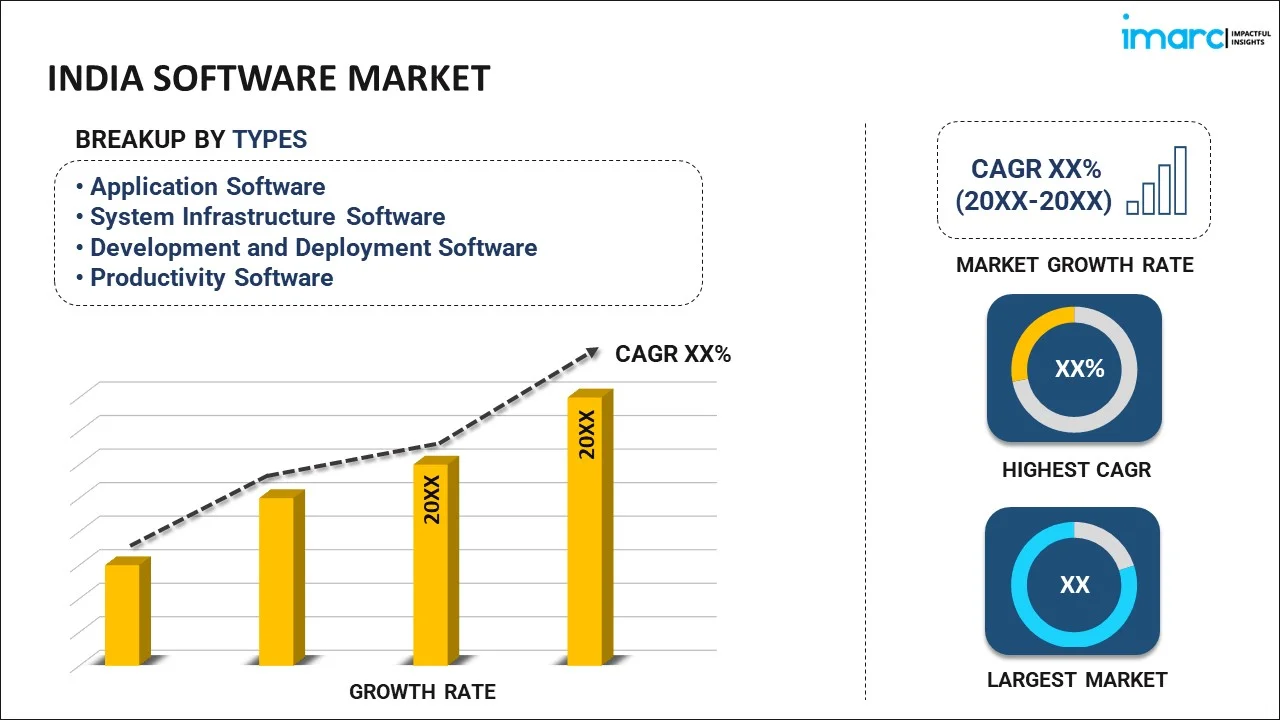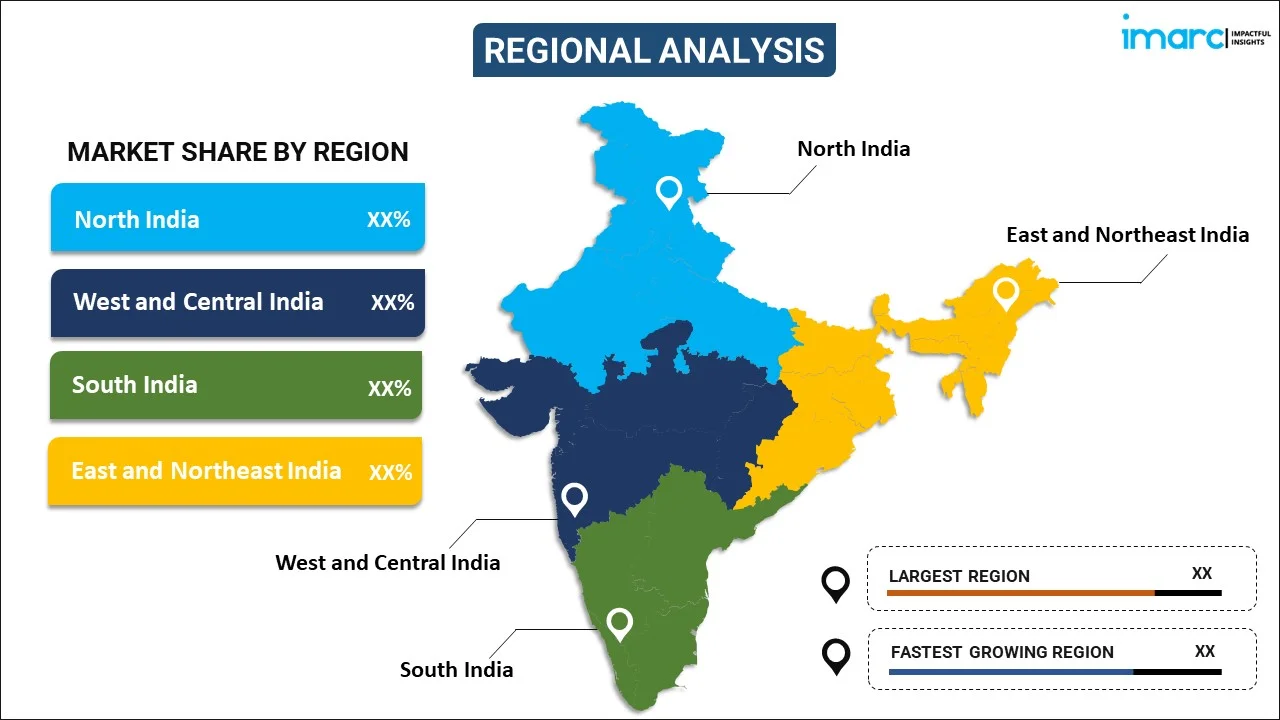
India Software Market Report by Type (Application Software, System Infrastructure Software, Development and Deployment Software, Productivity Software), Deployment Mode (On-premises, Cloud-based), Enterprise Size (Small and Medium-sized Enterprises, Large Enterprises), Industry Vertical (IT and Telecom, BFSI, Retail, Government/Public Sector, Energy and Utilities, Healthcare, and Others), and Region 2025-2033
Market Overview:
India software market size reached USD 21.1 Billion in 2024. Looking forward, IMARC Group expects the market to reach USD 61.5 Billion by 2033, exhibiting a growth rate (CAGR) of 11.7% during 2025-2033. The increasing demand for cloud computing, which offers scalability, flexibility, and cost-effectiveness, thereby allowing businesses to access and deploy software applications without the need for extensive infrastructure, is driving the market.
|
Report Attribute
|
Key Statistics
|
|---|---|
|
Base Year
|
2024
|
|
Forecast Years
|
2025-2033
|
|
Historical Years
|
2019-2024
|
| Market Size in 2024 | USD 21.1 Billion |
| Market Forecast in 2033 | USD 61.5 Billion |
| Market Growth Rate 2025-2033 | 11.7% |
Software refers to a set of instructions that enable a computer to perform specific tasks or functions. It encompasses both application software, like word processors and games, and system software, such as operating systems that manage hardware resources. Software is a critical component of modern computing, driving the functionality of devices ranging from smartphones to supercomputers. It is created through programming languages, where developers write code to instruct computers on how to execute desired operations. Continuous advancements in software development lead to improved efficiency, enhanced user experiences, and the creation of innovative solutions across various industries. The evolution of software is marked by constant updates, bug fixes, and the introduction of new features to meet the ever-changing demands of technology users.
India Software Market Trends:
The software market in India is propelled by a multitude of dynamic factors, each intricately linked to the ever-evolving landscape of technology. Firstly, the relentless pace of innovation acts as a driving force, spurring demand for cutting-edge software solutions that can harness emerging technologies like artificial intelligence, machine learning, and the Internet of Things. Moreover, the escalating digitization across industries is a key driver, compelling businesses to invest in software to streamline operations, enhance efficiency, and stay competitive in the digital era. In addition to this, the regional shift towards remote work has significantly contributed to the surge in demand for collaborative and communication software, fostering a robust market for tools that facilitate seamless virtual collaboration. Concurrently, the escalating need for cybersecurity solutions in the face of increasingly sophisticated threats has fueled the growth of the software security market. Furthermore, the rising adoption of cloud computing has revolutionized software delivery, enabling scalable and flexible solutions that cater to diverse business needs. Ultimately, the interplay of these interconnected factors creates a dynamic ecosystem that propels the software market forward as businesses continually seek innovative solutions to navigate the challenges and opportunities presented by the rapidly evolving technological landscape.
India Software Market Segmentation:
IMARC Group provides an analysis of the key trends in each segment of the market, along with forecasts at the country level for 2025-2033. Our report has categorized the market based on type, deployment mode, enterprise size, and industry vertical.
Type Insights:

- Application Software
- Enterprise Resource Planning (ERP)
- Customer Relationship Management (CRM)
- Supply Chain Management (SCM)
- Enterprise Collaboration Software
- Enterprise Content Management (ECM) Software
- Education Software
- Others
- System Infrastructure Software
- Network Management Systems (NMS)
- Storage Software
- Security Software
- Development and Deployment Software
- Enterprise Data Management (EDM)
- Business Analytics and Reporting Tools
- Application Servers
- Integration and Orchestration Middleware
- Data Quality Tools
- Productivity Software
- Office Software
- Creative Software
- Others
The report has provided a detailed breakup and analysis of the market based on the type. This includes application software (enterprise resource planning (ERP), customer relationship management (CRM), supply chain management (SCM), enterprise collaboration software, enterprise content management (ECM) software, education software, and others), system infrastructure software (network management systems (NMS), storage software, and security software), development and deployment software (enterprise data management (EDM), business analytics and reporting tools, application servers, integration and orchestration middleware, and data quality tools), and productivity software (office software, creative software, and others).
Deployment Mode Insights:
- On-premises
- Cloud-based
A detailed breakup and analysis of the market based on the deployment mode have also been provided in the report. This includes on-premises and cloud-based.
Enterprise Size Insights:
- Small and Medium-sized Enterprises
- Large Enterprises
The report has provided a detailed breakup and analysis of the market based on the enterprise size. This includes small and medium-sized enterprises and large enterprises.
Industry Vertical Insights:
- IT and Telecom
- BFSI
- Retail
- Government/Public Sector
- Energy and Utilities
- Healthcare
- Others
A detailed breakup and analysis of the market based on the industry vertical have also been provided in the report. This includes IT and telecom, BSFI, retail, government/public sector, energy and utilities, healthcare, and others.
Regional Insights:

- North India
- West and Central India
- South India
- East and Northeast India
The report has also provided a comprehensive analysis of all the major regional markets, which include North India, West and Central India, South India, and East and Northeast India.
Competitive Landscape:
The market research report has also provided a comprehensive analysis of the competitive landscape. Competitive analysis such as market structure, key player positioning, top winning strategies, competitive dashboard, and company evaluation quadrant has been covered in the report. Also, detailed profiles of all major companies have been provided.
India Software Market Report Coverage:
| Report Features | Details |
|---|---|
| Base Year of the Analysis | 2024 |
| Historical Period | 2019-2024 |
| Forecast Period | 2025-2033 |
| Units | Billion USD |
| Scope of the Report | Exploration of Historical Trends and Market Outlook, Industry Catalysts and Challenges, Segment-Wise Historical and Future Market Assessment:
|
| Types Covered |
|
| Deployment Modes Covered | On-premises, Cloud-based |
| Enterprise Sizes Covered | Small and Medium-sized Enterprises, Large Enterprises |
| Industry Verticals Covered | IT and Telecom, BFSI, Retail, Government/Public Sector, Energy and Utilities, Healthcare, Others |
| Regions Covered | North India, West and Central India, South India, East and Northeast India |
| Customization Scope | 10% Free Customization |
| Post-Sale Analyst Support | 10-12 Weeks |
| Delivery Format | PDF and Excel through Email (We can also provide the editable version of the report in PPT/Word format on special request) |
Key Questions Answered in This Report:
- How has the India software market performed so far and how will it perform in the coming years?
- What has been the impact of COVID-19 on the India software market?
- What is the breakup of the India software market on the basis of type?
- What is the breakup of the India software market on the basis of deployment mode?
- What is the breakup of the India software market on the basis of enterprise size?
- What is the breakup of the India software market on the basis of industry vertical?
- What are the various stages in the value chain of the India software market?
- What are the key driving factors and challenges in the India software?
- What is the structure of the India software market and who are the key players?
- What is the degree of competition in the India software market?
Key Benefits for Stakeholders:
- IMARC’s industry report offers a comprehensive quantitative analysis of various market segments, historical and current market trends, market forecasts, and dynamics of the India software market from 2019-2033.
- The research report provides the latest information on the market drivers, challenges, and opportunities in the India software market.
- Porter's five forces analysis assist stakeholders in assessing the impact of new entrants, competitive rivalry, supplier power, buyer power, and the threat of substitution. It helps stakeholders to analyze the level of competition within the India software industry and its attractiveness.
- Competitive landscape allows stakeholders to understand their competitive environment and provides an insight into the current positions of key players in the market.
Need more help?
- Speak to our experienced analysts for insights on the current market scenarios.
- Include additional segments and countries to customize the report as per your requirement.
- Gain an unparalleled competitive advantage in your domain by understanding how to utilize the report and positively impacting your operations and revenue.
- For further assistance, please connect with our analysts.
 Inquire Before Buying
Inquire Before Buying
 Speak to an Analyst
Speak to an Analyst
 Request Brochure
Request Brochure
 Request Customization
Request Customization




.webp)




.webp)












